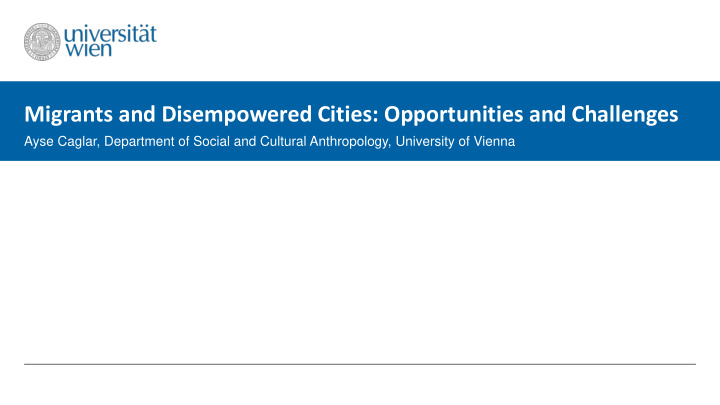



Migrants and Disempowered Cities: Opportunities and Challenges Ayse Caglar, Department of Social and Cultural Anthropology, University of Vienna
Two striking Characteristics of scholarship on the relationship between migrants and cities • Generating theory and policies from the particular experiences of metropoles or gateway cities, ignoring the differing dynamics in cities of varying scale. ◦ We need to counter this tendency (methodological nationalism) of most of migration and policy studies. • Urban redevelopment narratives mask growing inequalities in and between cities. ◦ We need to address the interrelated processes of wealth generation through urban redevelopment, increasing disparities, and migrant settlement. 07/09/2017 To edit footer please use "Header & Footer" in ribbon "Insert > Text" Page 2
Countering these tendencies • Focusing on cities of varying size, scale, and power ◦ Disempowered cities (marked by decimated economies, loss of population, tax base, economic, political and cultural power). • Developing a new analytical vocabulary • To capture the interdependencies between the dispossessive processes and displacements underlying urban redevelopment that often remain veiled in studies on the relationships between migrants and cities 07/09/2017 To edit footer please use "Header & Footer" in ribbon "Insert > Text" Page 3
The building blocks of a new conceptual network • Displacement rather than “mobility” ◦ Enables us to draw attention to the processes underlying migration - Displacement dispossession and accumulation - How seemingly independent processes and locations as well as institutions are ultimately connected with each other • Emplacement – a processual concept ◦ “The relationship between the continuing restructuring of place within multiscalar networks of power, and a person’s efforts, within the barriers and opportunities that contingencies of local place-making offer, to build a life within networks of local, national, supranational, and global interconnections” 07/09/2017 To edit footer please use "Header & Footer" in ribbon "Insert > Text" Page 4
Moving beyond Binaries • Approaching the dynamics of migrants and those who see themselves as natives in city-making within the same analytical framework ◦ Addressing common conditions of precarity and displacement many urban residents are subject to ◦ Situating migrants as contemporaries of all other urban residents - (coevalness – historical conjuncture) 07/09/2017 To edit footer please use "Header & Footer" in ribbon "Insert > Text" Page 5
Utility of Focusing on Disempowered Cities • Disempowered – in terms of access to national power, capital investments, global talent - position within global networks of power - limited resources and power • The multiple ways migrants contribute to city-making can be more readily studied • New insights into the different opportunities for migrant emplacement • Fault lines of neoliberal urban redevelopment - contradictions and effects of dispossessions and displacements underlying urban regenerations become more visible • Migrant friendly narratives of leaders 07/09/2017 To edit footer please use "Header & Footer" in ribbon "Insert > Text" Page 6
The broader context of strategies and policies of urban redevelopment • Cities – unleashing - as engines of economy, centers of trade, investment and innovation ◦ Restructuring of capital - the changing configurations of state and local power ◦ Altering the value regimes in cities. All urban resources acquire a new value ◦ Migrants and refugees become assets ◦ attracting capital and investment to the city - performing the safe, open, and business friendly environment of the city (countering the city’s image as dangerous, declining and racist) 07/09/2017 To edit footer please use "Header & Footer" in ribbon "Insert > Text" Page 7
Findings – Similarities • Migrant friendly narratives closely entangled with business (capital – foreign, multinational) friendly narratives in urban redevelopment • No migrant-specific policies, but incentives to attract capital and investments (subsidies, tax rebates, provision of public resources to corporate capital) • Urban development by public expenditure- contributing to corporate coffers ◦ increased debt ◦ fewer public services ◦ increased poverty 07/09/2017 To edit footer please use "Header & Footer" in ribbon "Insert > Text" Page 8
Opportunities and Challenges • Two contradictory developments 1. Lack of resources and and programmes for the institutionalization of (ethnic and religious) difference - opportunities for migrants, refugees and the natives to build sociabilities based on domains of commonality-local politics - Striking examples of migrants in local politics, in social justice movements 2. Increased racism – migrants as the scapegoat of the effects of dispossessive dynamics of urban restructuring - failing public services, impoverishment 07/09/2017 To edit footer please use "Header & Footer" in ribbon "Insert > Text" Page 9
Recommend
More recommend